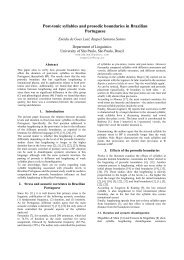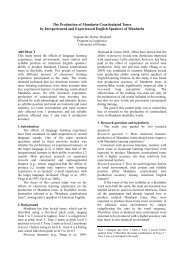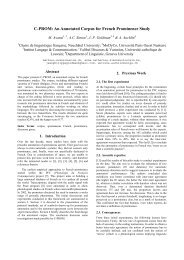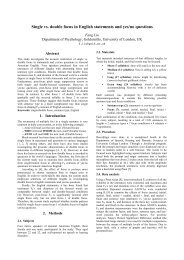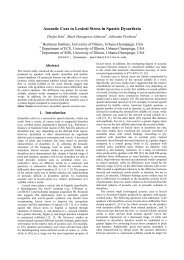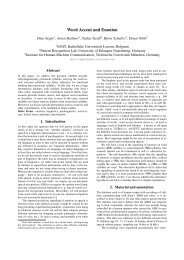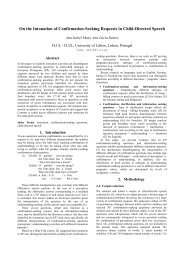The prosody of embedded coordinations in German and Hindi
The prosody of embedded coordinations in German and Hindi
The prosody of embedded coordinations in German and Hindi
Create successful ePaper yourself
Turn your PDF publications into a flip-book with our unique Google optimized e-Paper software.
clear difference to basel<strong>in</strong>e <strong>in</strong> this case, i.e. the two pr<strong>in</strong>ciples<br />
cancel each other out. On the other h<strong>and</strong>, if the pr<strong>in</strong>ciples<br />
agree <strong>in</strong> their predictions, the prosodic effect is strengthened:<br />
Compare N1 <strong>in</strong> conditions (b) <strong>and</strong> (d): While <strong>in</strong> (b), only<br />
Similarity requires lengthen<strong>in</strong>g <strong>of</strong> N1, both Similarity <strong>and</strong><br />
Anti-Proximity call for the lengthen<strong>in</strong>g <strong>in</strong> (d). As a<br />
consequence, N1 is longer <strong>and</strong> upstepped <strong>in</strong> (d) compared to<br />
(b).<br />
A difference from <strong>German</strong> was unavoidable: the coord<strong>in</strong>ated<br />
names were always followed by the postposition ke saath<br />
‘with’, as the context <strong>of</strong> the target sentence required a<br />
postpositional phrase.<br />
Disambiguat<strong>in</strong>g contexts, spoken by a male native speaker<br />
<strong>of</strong> H<strong>in</strong>di, had been previously recorded <strong>in</strong> a speech record<strong>in</strong>g<br />
lab <strong>in</strong> the University <strong>of</strong> Potsdam. <strong>The</strong> experiment was carried<br />
out <strong>in</strong> a quiet room at the University <strong>of</strong> Delhi. Devanagari<br />
script was used for contexts <strong>and</strong> target sentences. Each item<br />
was presented as follows. Participants saw a context question<br />
<strong>and</strong> its answer on a 15’’ laptop screen <strong>and</strong> simultaneously<br />
heard the question over headphones. Aga<strong>in</strong>, the target<br />
sentences were presented with parentheses. Participants were<br />
<strong>in</strong>structed to read out the target sentence as a response to the<br />
question they heard. In case <strong>of</strong> hesitation or slips <strong>of</strong> the<br />
tongue, they were asked to repeat the answer. <strong>The</strong> participants’<br />
answers were recorded on a DAT tape recorder us<strong>in</strong>g a<br />
SM10A head set microphone. 20 female native speakers <strong>of</strong><br />
H<strong>in</strong>di from the Delhi area participated <strong>in</strong> the experiment.<br />
<strong>The</strong> full set <strong>of</strong> 480 target sentences was segmented <strong>and</strong><br />
h<strong>and</strong> annotated on the word level by three phonetically tra<strong>in</strong>ed<br />
students at Potsdam University, checked by H<strong>in</strong>di native<br />
speakers <strong>and</strong> subjected to phonetic analysis.<br />
2.2.2. Results <strong>and</strong> Discussion<br />
<strong>The</strong> results <strong>of</strong> the H<strong>in</strong>di speech production experiment are<br />
depicted <strong>in</strong> Figures 3 <strong>and</strong> 4.<br />
Figure 2: Time-normalized <strong>in</strong>terpolated mean F0 tracks (<strong>in</strong><br />
Hz) <strong>of</strong> basel<strong>in</strong>e 5a (grey) plotted aga<strong>in</strong>st conditions 5b, 5c, 5d,<br />
5e <strong>and</strong> 5f (black)<br />
While Wagner’s SBR <strong>and</strong> Watson <strong>and</strong> Gibson’s LRB can<br />
account for some <strong>of</strong> the effects found here, they fail to predict<br />
prosodic effects <strong>in</strong> critical conditions. <strong>The</strong> LRB, for example,<br />
cannot expla<strong>in</strong> the longer duration <strong>of</strong> N1 <strong>in</strong> condition (b) that<br />
is predicted by Similarity. <strong>The</strong> SBR fails to predict the<br />
shorten<strong>in</strong>g <strong>of</strong> N1 <strong>in</strong> conditions (c), (e) <strong>and</strong> (f), or <strong>of</strong> N3 <strong>in</strong> (b),<br />
(d), (f) which is straightforwardly derived from Proximity.<br />
2.2. H<strong>in</strong>di<br />
2.2.1. Material <strong>and</strong> Method<br />
In H<strong>in</strong>di, as well, four lexically unique coord<strong>in</strong>ation structures<br />
with usual names were devised. <strong>The</strong> sentences appear <strong>in</strong> the<br />
same six syntactic conditions as <strong>in</strong> <strong>German</strong> (see (5)); the<br />
<strong>coord<strong>in</strong>ations</strong> aur ‘<strong>and</strong>’ <strong>and</strong> yaa ‘or’ were used with<strong>in</strong> <strong>and</strong><br />
outside <strong>of</strong> the group<strong>in</strong>gs respectively. An example is given <strong>in</strong><br />
(6).<br />
(6) (viral aur vaaman) yaa (yaman aur yogi) ke saath<br />
Viral <strong>and</strong> Vaaman or Yaman <strong>and</strong> Yogi with<br />
‘With Viral <strong>and</strong> Vaaman or Yaman <strong>and</strong> Yogi’<br />
Figure 3: Durational (upper panel) <strong>and</strong> F0 differences (lower<br />
panel) between basel<strong>in</strong>e (0) <strong>and</strong> other conditions on the four<br />
names. Error bars depict 95% confidence <strong>in</strong>tervals.<br />
No reliable differences between the conditions were found<br />
with respect to F0 (cf. lower panel <strong>of</strong> Figure 3). Quite to the<br />
contrary, the F0-patterns <strong>of</strong> the six conditions show a strik<strong>in</strong>g<br />
similarity with ris<strong>in</strong>g pitch on each name irrespective <strong>of</strong> its<br />
syntactic status <strong>in</strong> the coord<strong>in</strong>ation structure (see Figure 4).<br />
Also, the durational values lack the differentiation that was<br />
found <strong>in</strong> the <strong>German</strong> experiment (see upper panel <strong>of</strong> Figure 3).<br />
<strong>The</strong> only pattern that shows a significant difference is<br />
condition (e), <strong>in</strong> which N2 <strong>and</strong> N3 are lengthened compared to<br />
basel<strong>in</strong>e. We cannot exclude that this effect is owed to general<br />
process<strong>in</strong>g difficulties with this condition rather than reflection<br />
<strong>of</strong> syntactic structure. Given the lack <strong>of</strong> further significant



